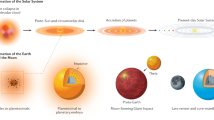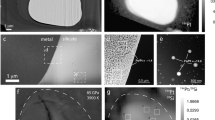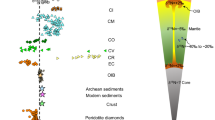Abstract
Core formation should strip highly siderophile elements (HSEs) from planetary mantles according to the expected metal–silicate partition coefficients1,2. However, studies of Earth3, the Moon4 and Mars5 indicate mantles with HSE abundances in chondrite-relative proportions that exceed the values expected from metal–silicate partitioning. Competing hypotheses have been proposed to account for these observations, including metal–silicate partitioning at higher pressures and temperatures6 and late accretion7. Here we present petrological and geochemical analyses of diogenite meteorites that represent mantle and crustal materials from two or more differentiated asteroids. We find that diogenites show HSE abundances that are consistent with metal–silicate equilibration, followed by minor continued accretion. Isotope chronometry supports diogenite crystallization ages within 2–3 million years of Solar System formation, indicating that late accretion occurred earlier than postulated for Earth, the Moon and Mars. The early timing and occurrence on differentiated asteroids, as well as on the larger terrestrial planets, therefore ties late accretion to planetary growth. On asteroidal bodies, such as the diogenite parent bodies, variations in HSE compositions may reflect regional rather than global effects. In contrast, for Earth, the Moon and Mars, compositional variations in mantle materials seem to be consistent with more homogeneous distributions through prolonged melting and/or solid-state convection.
This is a preview of subscription content, access via your institution
Access options
Subscribe to this journal
Receive 12 print issues and online access
$259.00 per year
only $21.58 per issue
Buy this article
- Purchase on Springer Link
- Instant access to full article PDF
Prices may be subject to local taxes which are calculated during checkout



Similar content being viewed by others
References
Jones, J. H. & Drake, M. J. Geochemical constraints on core formation in the Earth. Nature 322, 221–228 (1986).
Borisov, A. & Palme, H. Experimental determination of the solubility of platinum in silicate melts. Geochim. Cosmochim. Acta 61, 4349–4357 (1997).
Becker, H. et al. Highly siderophile element composition of the Earth’s primitive upper mantle: Constraints from new data on peridotite massifs and xenoliths. Geochim. Cosmochim. Acta 70, 4528–4550 (2006).
Day, J. M. D., Pearson, D. G. & Taylor, L. A. Highly siderophile element constraints on accretion and differentiation of the Earth–Moon system. Science 315, 217–219 (2007).
Brandon, A. D. et al. Evolution of the martian mantle inferred from 187Re–187Os isotope and highly siderophile element abundance systematics of shergottite meteorites. Geochim. Cosmochim. Acta 76, 206–235 (2012).
Murthy, V. Early differentiation of the Earth and the problem of mantle siderophile elements. A new approach. Science 253, 303–306 (1991).
Chou, C-L. Fractionation of siderophile elements in the Earth’s upper mantle. Proc. Lunar Planet. Sci. Conf. 9, 219–230 (1978).
Albarède, F. Volatile accretion history of the terrestrial planets and dynamic implications. Nature 461, 1227–1233 (2009).
Walker, R. J. Highly siderophile elements in the Earth, Moon and Mars: Update and implications for planetary accretion and differentiation. Chem. Erde 69, 101–125 (2009).
Day, J. M. D., Walker, R. J., James, O. B. & Puchtel, I. S. Osmium isotope and highly siderophile element systematics of the lunar crust. Earth Planet. Sci. Lett. 289, 595–605 (2010).
McCord, T. B., Adams, J. B. & Johnson, T. V. Asteroid Vesta: Spectral reflectivity and compositional implications. Science 168, 1445–1447 (1970).
Binzel, R. P. & Xu, S. Chips off asteroid 4 Vesta: Evidence for the parent body of basaltic achondrite meteorites. Science 260, 186–191 (1993).
Scott, E. R. D., Greenwood, R. C., Franchi, I. A. & Sanders, I. S. Oxygen isotopic constraints on the origin and parent bodies of eucrites, diogenites, and howardites. Geochim. Cosmochim. Acta 73, 5835–5853 (2009).
Schiller, M. et al. Rapid timescales for magma ocean crystallisation on the howardite–eucrite–diogenite parent body. Astrophys. J. 740, L22 (2011).
Trinquier, A., Birck, J-L., Allègre, C. J., Göpel, C. & Ulfbeck, D. 53Mn–53Cr systematics of the early Solar System revisited. Geochim. Cosmochim. Acta 72, 5146–5163 (2008).
Nyquist, L. E., Kleine, T., Shih, C-Y. & Reese, Y. D. The distribution of short-lived radioisotopes in the early solar system and the chronology of asteroid accretion, differentiation, and secondary mineralization. Geochim. Cosmochim. Acta 73, 5115–5136 (2009).
Taylor, S. R. & McLennan, S. M. Planetary Crusts: Their Composition, Origin and Evolution 400 pp. (Cambridge Univ. Press, 2009).
Shearer, C. K., Burger, P. & Papike, J. J. Petrogenetic relationships between diogenites and olivine diogenites: Implications for magmatism on the HED parent body. Geochim. Cosmochim. Acta 74, 4865–4880 (2010).
Greenwood, R. C., Franchi, I. A., Jambon, A. & Buchanan, P. C. Widespread magma oceans on asteroidal bodies in the early Solar System. Nature 435, 916–918 (2005).
Warren, P. H., Kallemeyn, G. W., Huber, H., Ulff-Moller, F. & Choe, W. Siderophile and other geochemical constraints on mixing relationships among HED-meteoritic breccias. Geochim. Cosmochim. Acta 73, 5918–5943 (2009).
Beck, A. W. & McSween, H. Y. Diogenites as polymict breccias composed of orthopyroxenite and harzburgite. Meteor. Planet. Sci. 45, 850–872 (2010).
Barrat, J. A., Yamaguchi, A., Zanda, B., Bollinger, C. & Bohn, M. Relative chronology of crust formation on asteroid Vesta: Insights from the geochemistry of diogenites. Geochim. Cosmochim. Acta 74, 6218–6231 (2010).
Lugmair, G. W. & Shukolyukov, A. Early Solar System timescales according to 53Mn–53Cr systematics. Geochim. Cosmochim. Acta 62, 2863–2886 (1998).
Dale, C. W. et al. Late accretion on the earliest planetesimals revealed by the highly siderophile elements. Science 336, 72–75 (2012).
Day, J. M. D. et al. Origin of felsic achondrites Graves Nunataks 06128 and 06129 and ultramafic brachinites and brachinite-like achondrites by partial melting of volatile-rich primitive parent bodies. Geochim. Cosmochim. Acta 81, 94–128 (2012).
Bowman, L. E., Papike, J. J. & Spilde, M. N. Diogenites as asteroidal cumulates: Insights from spinel chemistry. Am. Min. 84, 1020–1026 (1999).
Brenan, J. M. & McDonough, W. F. Core formation and metal-silicate fractionation of osmium and iridium from gold. Nature Geosci. 2, 798–801 (2009).
Bogard, D. & Garrison, D. 39Ar–40Ar ages of eucrites and thermal history of asteroid 4 Vesta. Meteor. Planet. Sci. 38, 669–719 (2003).
Kleine, T. et al. Hf–W chronology of the accretion and early evolution of asteroids and terrestrial planets. Geochim. Cosmochim. Acta 73, 5150–5188 (2009).
Dauphas, N. & Pourmand, A. Hf–W–Th evidence for rapid growth of Mars and its status as a planetary embryo. Nature 473, 489–492 (2011).
Horan, M. F., Walker, R. J., Morgan, J. W., Grossman, J. N. & Rubin, A. E. Highly siderophile elements in chondrites. Chem. Geol. 196, 5–20 (2003).
Acknowledgements
We are grateful to A. J. Irving, the Meteorite Working Group and the NASA Johnson Space Center curatorial staff for provision of samples, R. D. Ash and P. M. Piccoli for analytical assistance and R. W. Carlson for access to the DTM/CIW laboratory. T. Kleine and A. J. Irving are gratefully acknowledged for providing comments. This work was made possible by financial support from NASA (NNX11AG34G, NNX12AH75G to J.M.D.D.; NNX10AG94G to R.J.W. and NNX07A48G to D.R.).
Author information
Authors and Affiliations
Contributions
J.M.D.D. and R.J.W. planned the project, J.M.D.D. and L.Q. carried out Mn–Cr isotope determinations, D.R. III carried out O isotope measurements and J.M.D.D. carried out all other measurements. All authors contributed to discussion and interpretation of results in the manuscript.
Corresponding author
Ethics declarations
Competing interests
The authors declare no competing financial interests.
Supplementary information
Supplementary Information
Supplementary Information (PDF 1779 kb)
Rights and permissions
About this article
Cite this article
Day, J., Walker, R., Qin, L. et al. Late accretion as a natural consequence of planetary growth. Nature Geosci 5, 614–617 (2012). https://doi.org/10.1038/ngeo1527
Received:
Accepted:
Published:
Issue Date:
DOI: https://doi.org/10.1038/ngeo1527
This article is cited by
-
Early silicic magmatism on a differentiated asteroid
Nature Geoscience (2022)
-
Common feedstocks of late accretion for the terrestrial planets
Nature Astronomy (2021)
-
Olivine-rich achondrites from Vesta and the missing mantle problem
Nature Communications (2021)
-
Accretion of the Earth—Missing Components?
Space Science Reviews (2020)
-
An aqueously altered carbon-rich Ceres
Nature Astronomy (2018)



